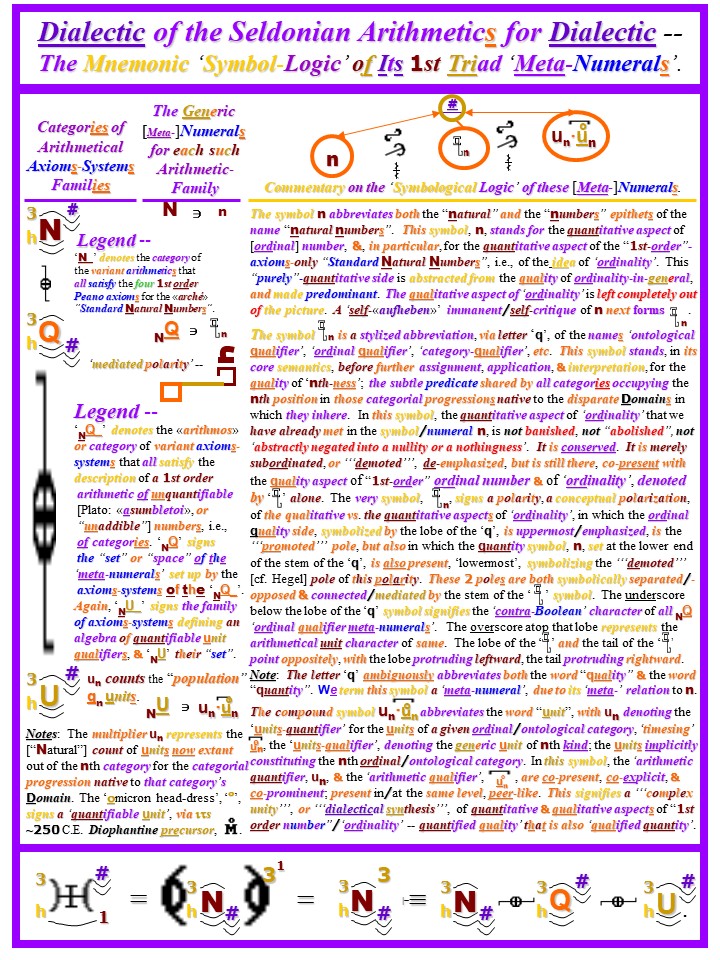‘The Advent of a ‘Dialectical Notation’ or
‘Notation for Dialectics’.
-- Part 03: Seldon’s Secrets Series.
Dear Reader,
It
is my pleasure,
and my honor, as an elected member
of the Foundation Encyclopedia
Dialectica [F.E.D.] General Council, and as a voting member of F.E.D., to share, with you, from time to time, as they are approved for public release, by the F.E.D. General Council, key excerpts from the internal writings, and from the internal sayings, of our co-founder,
Karl Seldon.
The third
release in
this new such
series is posted below
[Some E.D.
standard edits have been applied, in the version presented below, by the editors of
the F.E.D. Special Council for the Encyclopedia,
to the direct transcript of our co-founder’s
discourse].
In this 3rd installment, Seldon describes the cruciality, for the advance of human
thought, of the advent of a ‘notation for dialectic’, i.e., a ‘dialectical
ideography’.
Seldon --
“It has been our
opportunity, our privilege, our honor, and our
pleasure to be the first to introduce a[n ideographical] ‘notation for
dialectics’, a ‘dialectical[-mathematical] ideography’, over the course of
these last > 22 years.”
“But
how should we assess the value, and the importance, of this
advent, of a ‘mathematics for dialectics’?”
“Let
us consider some possible analogies between this advent and past
but similar advents in other fields of human endeavor, to help with such an
assessment.”
“Where
would humanity be without the advent of alphabetic, ‘phono-gram-ic’
written language notation?”
“Where
would music be without the notation for scoring…that allows the writing down,
and thus the potential and actual preservation, and accumulation, of our
musical cultural heritage…. For one thing,
without music notation, there would be no music composers…”
“Where
would formal logic be without the ‘ideo-gram-ic-al’ notations, not
just of the ‘sentence-calculus’, but of the “first order predicate calculus”,
as well as of the – albeit less fully-explored and comprehended – higher order
predicate calculi, predicate calculi of higher-than-first-order, and… of
mathematical logic and the notation of “meta-mathematics” in particular…. Perhaps without that developed ideography, the
discovery of Goedel’s Incompleteness Theorems would have been delayed, perhaps
even indefinitely. …”
“Where
would mathematics – hence mathematical science – be?”
“Where
would geometry be, without its eons-old notation of letters, “characters”,
denoting “points”, letter pairs denoting lines, etc., that date back to even
before Euclid wrote his Elements?...”
“…Not
even to mention later, modern developments in advanced geometrical notation,
including the “tensor analysis” notation that Einstein used to express his Theory
of General Relativity?”
“Where
would arithmetic be, without the number/placeholder 0, a positive, explicit symbolic presence for a “purely” quantitative
content that is in absence,
e.g., without the Indo-Arabic numeralic notation?...
“Where would algebra be, without the ability to succinctly notate general constants, via literals, or “characters”, and without a notation to make symbolically present, in its equations, a numerical content the precise knowledge of which is presently not yet present?...”
“…The
primary reason why we predicate this notational system, this
ideography, as ‘‘‘dialectical’’’, is that we interpret it as
dealing with ontological categories, i.e., with categorial oppositions and with
the resolution of those categorial oppositions. …”
“…Our
new and unprecedented ‘notation for dialectics’, has, for us,
provided access to an advanced phase of human cognition, to enhanced insight, to
accelerated discovery, to amplified problem-solving capability, and to deeper
penetration into the mysteries, and into the conundrums, of our natural,
including of our human, cosmos. That ‘dialectic-notation’
is one of the key secrets to our successes.”
For more information regarding these Seldonian insights, please see --
For partially pictographical, ‘poster-ized’ visualizations of many of these Seldonian insights -- specimens of ‘dialectical art’ -- see:
https://www.etsy.com/shop/DialecticsMATH
¡ENJOY!
Regards,
Miguel
Detonacciones,
Voting Member, Foundation Encyclopedia Dialectica [F.E.D.];
Elected Member, F.E.D. General Council;
Participant, F.E.D. Special Council for Public Liaison;
Officer, F.E.D. Office of Public Liaison.
Please post your comments on this blog-entry below!








No comments:
Post a Comment